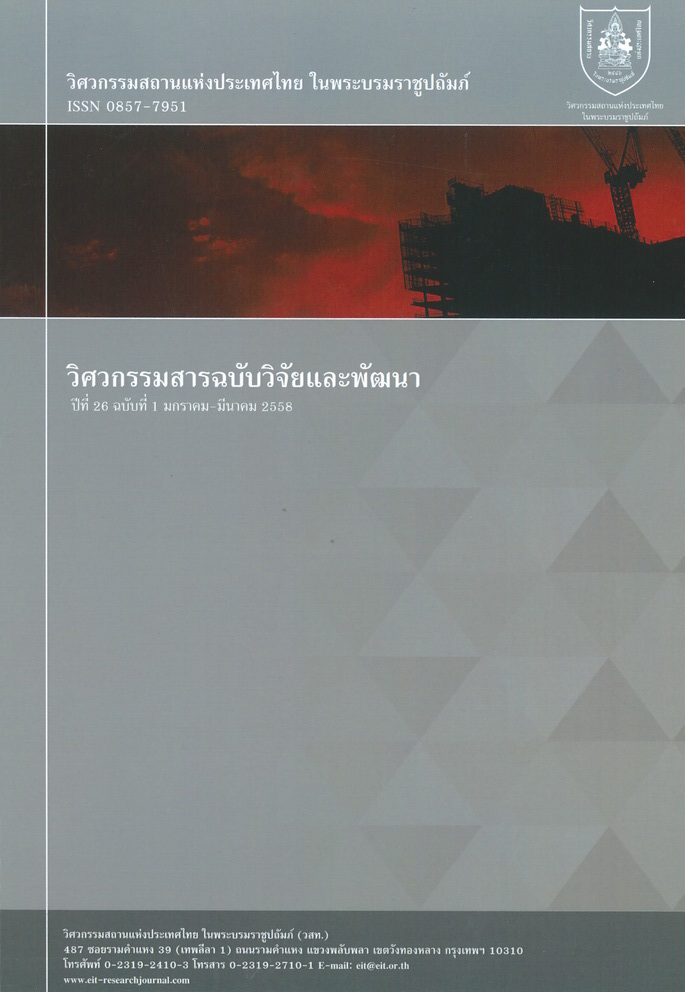THE DEVERLOPMENT OF AN ANTHROPOMETRY APPLICATION ON TABLET
Main Article Content
Abstract
การวัดขนาดสัดส่วนร่างกายด้วยหลักการยศาสตร์นั้นการใช้วิธีในการเก็บข้อมูลแบบอื่นๆนอกจากการใช้ Anthropometer แล้วยังมีการถ่ายภาพการใช้เทคโนโลยีริ้วเเสง (Light stripe) การใช้เทคนิคมอเร (Moire Technique) วิธีดังกล่าวนั้นต้องใช้อุปกรณ์หลายชิ้นและมีความซับซ้อนในการใช้งานด้วยความก้าวหน้าทางเทคโนโลยีแท็บเล็ต (Tablet)สามารถรวบขั้นตอนตั้งแต่การถ่ายภาพ การกำหนดมาตราส่วนและการวัดขนาดไว้ด้วยกัน ผู้วิจัยจึงได้พัฒนาโปรแกรมวัดขนาดสัดส่วนร่างกายที่สามารถใช้งานบนแท็บเล็ตซึ่งพัฒนาขึ้นโดยใช้การหาขอบภาพด้วย Canny Edge Detection จากการศึกษางานวิจัยที่ผ่านมาทำให้ทราบว่าระยะห่างระหว่างวัตถุกับกล้อง แท็บเล็ตและปริมาณความเข้มแสงสว่างทั่วไปมีผลต่อความผิดพลาดในการวัด ดังนั้นขั้นตอนแรกของการพัฒนาจึงได้เริ่มต้นจากการหาระยะห่างระหว่างวัตถุกับกล้องแท็บเล็ตและปริมาณความเข้มแสงสว่างทั่วไปที่ผิดพลาดน้อยที่สุด คือที่ระยะ 6 เมตรและปริมาณความเข้มแสงสว่างที่ 400 ลักซ์จากนั้นจึงได้ทดสอบใช้งานโดยการวัดขนาดสัดส่วนร่างกาย 20 มิติ จากผู้เข้าร่วมทดลอง 50 คนอายุระหว่าง 19-67 ปี พบว่าค่าความผิดพลาดน้อยที่สุดคือ มิติความสูงยืน เท่ากับ 0.51% มากที่สุดคือ มิติความกว้างของศีรษะ เท่ากับ4.18%และมีค่าความผิดพลาดเฉลี่ยทุกสัดส่วนเท่ากับ 1.97%
An anthropometrydata collectioncommonly uses ananthropometer.Moreover, there is the photogrammetric method such as the light stripe technique and the Moire technique. Those methods required manyequipments and complicated to use. Due to technological advance, a tablet device can combine the procedures from taking photography, determining the scale and measuring together. The experiment has developed tablet application to measure human proportions by developingwith Canny Edge Detection technique. The previous research showed that the distance (between the object and the camera tablet) and the illumination had an affect on the error of the measurement. Therefore, the development began from finding the best condition of distance and illumination.The results showed that the best condition of distancewas 6 meters and illumination was 400 lx. Thenmeasurementverifyingof proportions of 20 dimensions from 50 participants (aged 19-67 years old). The study found that the minimum error was0.51% at the Stature.The maximum error was4.18%at the Head breadth and the average error of all human proportions was 1.97%.
Article Details
The published articles are copyright of the Engineering Journal of Research and Development, The Engineering Institute of Thailand Under H.M. The King's Patronage (EIT).


